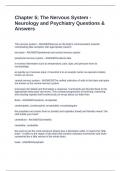Chapter 5; The Nervous System -
Neurology and Psychiatry Questions &
Answers
The nervous system - ANSWERSserves as the body's communication network,
coordinating data reception with appropriate reaction
two parts - ANSWERSperipheral and central nervous system
peripheral nervous system - ANSWERScollects data
it receives information such as temperature, pain, light, and pressure from its
surroundings
as quickly as it receives input, it transmits it to an analytic center via special conduits
known as nerves.
central nervous system - ANSWERSThe unified collection of cells in the brain and spine
are known as the central nervous system
processes the details and formulates a response. Commands are directed back to the
appropriate body parts via nerves. This constant progression of receiving, reasoning,
and reacting repeats itself continuously as we go about our daily lives.
Brain - ANSWERScerebr/o, encephal/o
cerebropathy, cerebrospinal, encephalitis, encephalogram
the ecephalo root comes from en (inside) and cephalus (head) and literally means "the
stuff inside your head"
cerebellum - ANSWERScerebell/o
cerebellar, cerebellitis
this word is just the word cerebrum (brain) plus a diminutive suffix. It means the "little
brain." It refers to the region of the brain that controls voluntary movements and looks
somewhat like a little version of the whole brain.
head - ANSWERScephal/o
,microephaly, macroephaly
the scientific term for octopus, squid, and other sea creatures that are made up of a
head and tentacles is cephalopod - literally head (cephalo) + foot (pod)
head, skull - ANSWERScrani/o
craniometer, craniomalacia
The term migraine comes from the word hemicranias, meaning "half the head." It
reflects the fact most migraines are localized on half the patient's head
meninges (membrane surrounding the brain and spinal cord) - ANSWERSmening/o,
meningi/o
meningitis, meningopathy
when the letter g is followed by an e or an i, it is pronounced soft (like j in jar): men-in-
JAI-tis. When the letter g is followed by a, o, or u, it is pronounced hard (like g in gas):
men-in-GOH-pah-thee
dura (tough outer membrane surrounding the brain and spinal cord) - ANSWERSdur/o
epidural, subdural hematoma
this root literally means "hard." The full name of the membrane it refers to is dura mate
cerebri, which translates to "the tough mother of the brain." words like endurance and
durable come from the same word
nerve - ANSWERSneur/o
neuralgia, neuropathy
neuron comes from a greek word meaning "tendon" or "string." In ancient times, when
people first began examining brains, they thought neurons looked like string
nerve bundle - ANSWERSgangli/o
ganglion, gangliitis
according to galen, a doctor in ancient rome, th eterm ganglion means "knot" and could
rather to anything gathered up into a ball, which is what galen thought nerve tissue
coming out of the brain looked like
spinal cord, bone marrow - ANSWERSmyel/o
, myelitis, myolodysplasia
this root comes from a Greek word meaning "the innermost part" and is used in
medicine to refer to two different things - bone marrow and the spinal cord. but if you
think about it, it makes sense, as both are in the innermost part of something else. Bone
marrow is in the center of bones. the spinal cord is in the center of the spine
feeling, sensation - ANSWERSesthesi/o
anesthesia, hyperesthesia
esthetics (also sometimes spelled asthetics) is the study of art and philosophy as it
pertains to beauty. What makes something beautiful? Can you measure beauty? Is
beauty really in the eye of the beholder?
speech - ANSWERSphas/o
aphasia
if a friend is talking too fast, perhaps he or she is stricken with the disease tachyphasia
mind - ANSWERSphren/o, psych/o
phrenetic, psychology
in addition to the mind, phren/o can also refer to the diaphragm (as in the term
phrenospasm, a fancy medical term for a hiccup). The reason comes from the ancient
Greek view of the mind. Early on, the greeks thought of the chest as the seat of emotion
and reason. As that view change and the location of the mind moved from the chest to
the brain, this term for mind began to be applied to both areas of the body
sleep - ANSWERSsomn/o, somn/I, hypn/o
somnography, insomnia, hypnosis
someone who walks while sleeping is experiencing somnambulation, whcih comes from
the words somno (sleep) + ambulo (walk)
know - ANSWERSgnosi/o
agnosia, diagnosis, prognosis
Frequently, people who have had a limb amputated report feeling or sensing the
missing limb. Such an experience is called autosomatognosis, from auto (self) + somato
(body) + gnosis (know).




